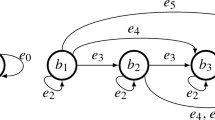Abstract
It is a common problem of all branches of mathematics to represent an object (algebraic structure, function etc.) by using other-possibly simpler — ones. Similarly, in the theory of automata such investigations are useful for two reasons. (1) For practical reasons, real automata are composed of various elements of certain type. (2) Several properties of a composition of automata can be deduced from those of its factors.
Access this chapter
Tax calculation will be finalised at checkout
Purchases are for personal use only
Preview
Unable to display preview. Download preview PDF.
Similar content being viewed by others
References
Gécseg, F., On loop-free composition of automata, Acta Sci. Math. 26 (1965), 269–272 (Russian).
Gécseg, F., On R-products of automata, II., Studia Sci. Math. Hung. 1 (1966), 443–447.
Gécseg, F., Families of automaton mappings, Acta Sci. Math. 28 (1967), 39–54 (Russian).
Gécseg, F., S. Székely, On equational classes of unoids, Acta Sci. Math. 34 (1973), 99–101.
Gluékov, V.M., Theory of abstract automata, Uspehi Matem. Nauk 16 (1961), 3–62 (Russian).
Hartmanis, J., Loop-free structure of sequential machines, Inform. Control (1962), 25–44.
Malcev, A.I., Algebraic systems ( Moskva, 1970 ) ( Russian).
Author information
Authors and Affiliations
Editor information
Editors and Affiliations
Rights and permissions
Copyright information
© 1974 Springer-Verlag Berlin Heidelberg
About this paper
Cite this paper
Gécseg, F. (1974). Composition of Automata. In: Loeckx, J. (eds) Automata, Languages and Programming. ICALP 1974. Lecture Notes in Computer Science, vol 14. Springer, Berlin, Heidelberg. https://doi.org/10.1007/978-3-662-21545-6_27
Download citation
DOI: https://doi.org/10.1007/978-3-662-21545-6_27
Publisher Name: Springer, Berlin, Heidelberg
Print ISBN: 978-3-540-06841-9
Online ISBN: 978-3-662-21545-6
eBook Packages: Springer Book Archive




